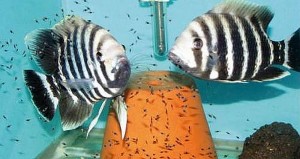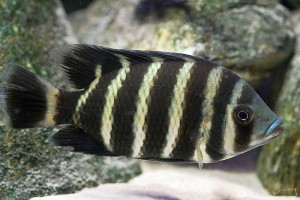Africa’s Hornet Cichlid (Tilapia buttikoferi) inhabits the coastal rivers of Western Africa from Guinea-Bissau to West Liberia and is also known to tropical fish keeping enthusiasts as the Buttikoferi Cichlid, Tiger Tilapia, Zebra Tilapia, and Hornet Tilapia.
Hornet Cichlids prefer the deeper waters and rocky habitats of vegetation choked West African rivers with salinities between next to nothing to nearly seawater strength at their mouths. They forage among the rock crevices for small crustaceans, worms, small fish, and vegetable matter. They are highly aggressive, extremely territorial, and in the wild maintain large territories.
The Hornet Cichlid is a large oval shaped, robust species that is colored black with a series of 7 to 9 yellow to white vertical bands running down the body.
The vertical black bars are broader than the lighter yellow or white bands, and their stripes tend to fade as they age. The head is colored a dusky yellow, their throat and fins are black, and all but their anal and pelvic fins have the same striping as the body.
The fins in mature males are more pointed than in females and they display a slight nuchal hump, especially during spawning.
Although juvenile Hornet Cichlids are relatively peaceful, their dispositions degrade as they grow older and they become extremely territorial.
Although they can be housed with other large aggressive or semi-aggressive fish, the Hornet Cichlid is best kept alone in a single species tank. They become extremely aggressive towards smaller fish, so if you don’t house them in a species tank, it is important to keep them with similar sized specimens.
The ideal setup for Hornet Cichlids is a large mature tank of at least 100 gallons with a medium size gravel substrate, some hardy (potted) plants, plenty of rock work, and several pieces of driftwood. They are diggers and tend to move around the decor in their surroundings, so any decorations should be securely anchored.
They are messy fish and require good filtration for their system. Canister filters are a perfect choice for these fish.
Hornet Cichlids or Buttikoferi Cichlids are substrate spawners and have been successfully bred in an aquarium environment as well as in commercial fish farms. Unfortunately, the males and females are colored identically so there is no sure way to differentiate between sexes.
Males are believed to be larger than females, but unless a breeding pair is purchased, the best way to obtain a pair is to place several juveniles in a large aquarium until a couple pairs off. When this occurs, remove the rest of the fish from the tank and condition the pair for breeding.
A slight increase in water temperature will sometimes induce spawning behavior. When ready to spawn, the pair will dig a pit in the substrate where the female lays her eggs. The male fertilizes them and both parents guard the eggs and fry until they are able to fend for themselves. The fry can be fed newly hatched baby brine shrimp and crushed omnivore flake food until larger foods can be eaten.
In an aquarium environment, Hornet Cichlids will eat almost anything placed in front of them. They do best with a quality omnivore cichlid stick as a staple, along with regular supplements of live, frozen, or freeze dried foods such as prawns, brine shrimp, mosquito larvae, earthworms, shrimp, and blanched peas or spinach. Two or three smaller feedings a day is preferred to a single feeding schedule.
The Hornet Cichlid is an extremely intelligent and aggressive aquarium species that reacts to movements outside of the aquarium glass. They can be “trained” by offering them food and they recognize their owners when they enter the room. Despite their aggressiveness, they remain popular with many tropical fish keeping enthusiasts.
Hornet Cichlids or Buttikoferi Cichlids are available online and through specialty tropical fish keeping shops. They are usually sold as juveniles when they are 1″ to 1-1/2″ in size, but can be purchased as proven pairs as adults.
Minimum Tank Size: 100 gallons
Care Level: Easy
Temperament: Aggressive
Aquarium Hardiness: Hardy
Water Conditions: 73-79° F, KH 10-15, pH 6.8-7.5
Max. Size: 14″
Color Form: Black, White, Yellow
Diet: Omnivore
Compatibility: Single species tank
Origin: Western Africa
Family: Cichlidae
Lifespan: 10-15 years
Aquarist Experience Level: Advanced





I purchased some Cichlids all were supposed to be South American, but the breeder slipped in one Hornet Cichlid by mistake. I didn’t know he was not South American until he grew for a few months and other fish went “missing”. Finally figured out what he was and now, he’s by himself with one hardy bottom dweller. He’s about 9 years old and quite large, and the way you describe their behavior is spot on for sure. My tank is only 75 gallons but he is still thriving. I can’t make myself get rid of him but I want some more color in the tank. I find it funny how active he is and how he moves everything around, including the fine gravel by the mouthful.
They do become quite gutsy..
Another funny thing is that he will only eat food that sinks, nothing on the surface.
Do you know of any shops or people who buy them when they are adults?
No. You can try some online auction sites or local fish shops.
I am looking for a buttikoferi cichlid, if you have a few I would like to purchase them. for shipping
We do not sell tropical fish on this site.
Try online like sites like https://www.liveaquaria.com/product/962/?pcatid=962
thank you I found someone who has many juvinelles
I would like to purchase a male and female buttikoferi cichlid, If you have any?
We do not sell tropical fish on this site. Suggest an online search or check sites like
https://aquariumfish.net/catalog_pages/cichlids_african/buttikoferi_for_sale.htm